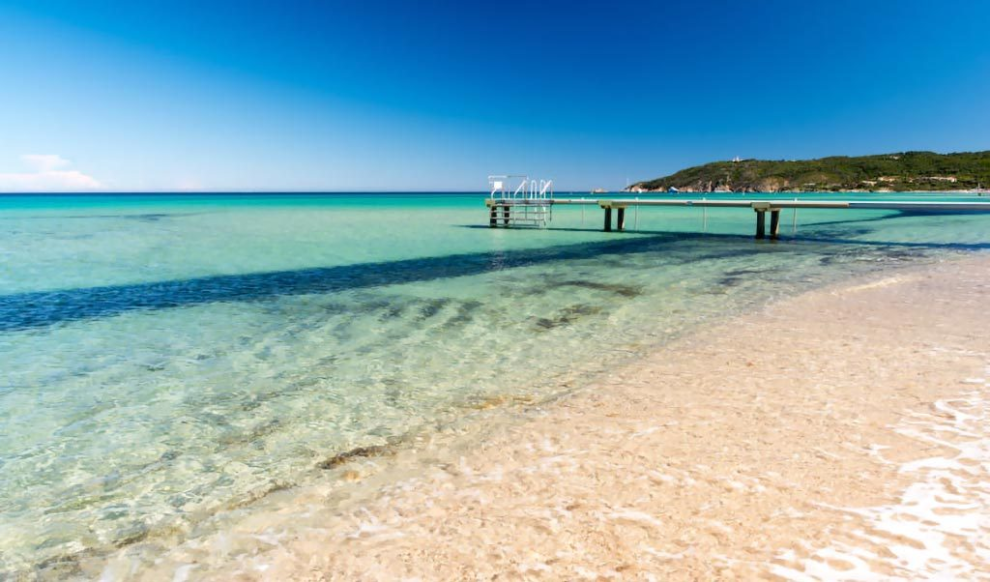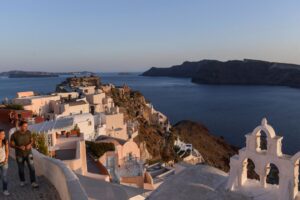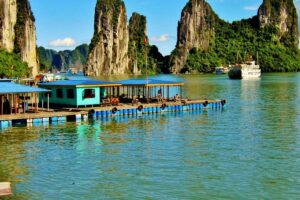Poised on the side of the catamaran, between Santorini and the active volcanic island of Nea Kameni, I hear Poseidon calling. The sparkling waters are layered like a marine moussaka of navy and turquoise, a light zephyr buffets salt-soaked skin, and every fibre tingles with anticipation.
“Dive, Mum, dive!” squeal my children, prompting a plunge headfirst into Grecian utopia. Adding to the sensory supernova is the wafting smell of fresh fish sizzling on the boat’s barbecue, the visual feast of whitewashed Oia on black cliffs, and the zinging taste of ocean. Every sense is on fire.
There’s something about the Mediterranean that makes you feel alive. Senses rev into top gear with simple joys – a whiff of hot French baguette, Italy’s super-sized, neon-hued lemons, Greece’s minimalist chic and Spain’s maximalist everything.
If you’re due for a long drink of soul juice – warm, gin-clear waters, eye-wateringly beautiful scenery and exploding flavours – splash this way to recharge, reset, rejoice, then rinse and repeat all summer long.
Saint-Tropez, France
It’s très difficile to bypass the Côte d’Azur, the sunbaked stretch from Monaco to Cannes heavy with the scent of suntan lotion and glamour. But make a beeline for Saint-Tropez, nestled in the spectacular Golfe de Saint-Tropez, which has 12 villages to explore.
Saint-Tropez has been chef Luke Mangan’s go-to for the past 15 years, not only for his favourite fresh seafood market, but “the wine and the clothes shopping, the people-watching and swimming, and drives to great nearby places like Ramatuelle”.
Why: Provence is lavender central, and the olfactory mother lode is the Valensole plateau, an aromatic daytrip from Saint-Tropez. In June and July, purple blooms are the stars, with a supporting cast of statuesque sunflowers and honey-coloured wheat.
Stay at: Sleep with nostrils filled with pine scent at the Hotel Storia in Ramatuelle and exhale with a rhythm of dips, naps and impromptu apéritifs. It’s a Provençal bastide (manor house) nestled in a protected forest next to the wild beach (no sun beds or pesky jet skis) of l’Escalet.
Eat here: Picnic in the Domaine du Bourrian in Gassin vineyards French-style. That means with premium local wines, charcuterie board and the earthy aromas of the vineyard itself. The bonus is a unique collection of antique tractors and replica planes.
Do this: Rent a vintage 2CV or Mehari from Les Deuch’moiselles based in Cogolin and find your own wildflower field.
Alternative: If you’re serious about scents, 45 minutes inland from Antibes is Grasse, the world’s perfume capital, producing scents for companies like Fragonard and Molinard. Create your own perfume at the Studio des Fragrances of the Parfumerie Galimard.
Cyprus
Cypriots are the second-largest international community in Australia and include actor Ada Nicodemou.
This southern Med idyll is what holiday brochures are made of, she says.
“You come here for an authentic experience – it’s quaint and less busy than other Med areas, with amazing food, great night-life and beautiful beaches. Plus, people are so friendly – everyone walks around saying hello.”
Why: It’s the pocket rocket of the Mediterranean. With left-hand driving, Cyprus is ripe for exploring, with bang for your buck both literally – it’s great value – and figuratively. It’s crammed with beauty, history and gastronomy in an easily navigable area.
Stay at: The Grecian Park is Ada’s favourite hotel, not only for the stellar premises and sandy beach at the bottom of cliff steps, “but it’s in my favourite area and is surrounded by tavernas”.
Eat here: Cypriot flavours are clean and fresh, loaded with coriander, lemon and Middle Eastern twists. For dinner, Ada raves about Ttappis Taverna, saying, “This is a place only the locals know about. It has traditional food, is so cheap, and the entire family cooks there.”
Do this: Plonk on a patch of golden-white sand at secluded Konnos Beach, which Ada calls “one of the most beautiful beaches in the world”. Explore mountain towns for old-school lifestyle and swim into mythology and peacock-blue waters around Petra tou Romiou (Aphrodite’s Rock), said to be the birthplace of the goddess of love.
Alternative: Malta is smaller again and packs historical punches including the Unesco megalithic temples – some of the oldest in the world.
Anacapri, Italy
Italy took one look at France’s 800km of Med coastline, said “I’ll raise you”, and threw down an ace of spades with 1500km of shores encompassing picturesque Cinque Terre in the north to pastel-perfect Positano and spicy Sicily in the south.
But the gastronomic centrepiece in a country already famed for food is the island of Capri. Particularly Anacapri, 30 minutes above – and a world away from – the human summertime stew clogging Capri town’s funicular and alleyways below.
Why: A favourite of Roman emperors for its beauty and bounty, Anacapri is still where locals go to indulge in the art of slow living and long, lingering lunches. Even a basic pasta with burro e salvia (butter and sage) is a showstopper.
Stay at: The Hotel Caesar Augustus Relais & Chateaux is pure Capri, from the yellow and white-striped awnings and riot of garden roses to the personal greeting by Francesco, son of the owner.
Eat here: The most romantic table in Capri is the hotel’s two-person Pensatoio (meaning “thinking area”) balcony. At dusk, dine like Caesar himself on tender scottadita lamb – it means “burnt fingers” because you’ll want to eat it straight off the grill – with the Bay of Naples spread below like a light-studded tablecloth.
Do this: Enjoy the double whammy of Da Gelsomina paddock-to-plate eating, before wandering in the adjacent wild nature of Parco Filosofico featuring quotes from more than 60 philosophers. Time doesn’t usually allow daytrippers to venture this far.
Alternative: Australian-Italian chef Valerio Fantinelli organises trips aboard a local fishing boat with a father-and-son team. If you’re lucky enough to snag a local sea bass or gilt-head bream, it’s cooked for lunch on the boat.
Milos, Greece
Nowhere on the planet is more welcoming than Greece. Every experience is laced with legendary “filotimo”, which global fitness mogul Kayla Itsines describes as “doing things with your heart, treating people like family and not expecting anything in return”. This might explain why being in Greece feels like a yiayia’s hug.
Why: Our pick is the geological gem of Milos, with impressive rock forms and abandoned mines. This Cycladic island hasn’t hit the top note of Santorini or Mykonos (yet) – catch it before it does.
Stay at: The Santa Maria Village Resort & Spa has rooms shaped like sugar cubes draped in fuchsia bougainvillea with chic interiors. It also has one the best and biggest pools in Milos.
Eat here: O! Hamos! Taverna by the port town of Adamas has been a standout for food and friendliness for almost three decades. All across Milos are similar family-run restaurants proudly practising slow cooking and inventive locavore menus.
Do this: If the ultimate holiday involves salty sea-dog feels, rent a mini speed boat to explore water-access-only areas like Kleftiko and the abandoned sulphur mine on Paliorema beach.
Alternative: For a deeper dip in Poseidon’s playground, sign up for a seven-day live-aboard adventure sailing from Corfu to lesser-known Ionian Islands such as Ithaca and Kefalonia, swapping wind power for pedal power on shore.
Ericeira, Portugal
Boom! That’s the sound of Nazaré, the home of supersonic big-wave surf. Portugal is the surf capital of Europe, and professional surfer Sophie McCulloch rates it as an ideal destination for Australians. “The waves are amazing. The water is cold but it’s nice being out in the raw elements, and out of the water there’s breathtaking views that are pretty much untouched. There’s a lot of sensory input to take in.”
Why here: Sophie’s top spot is Ericeira, a one-time fishing village 45 minutes from Lisbon that’s been fully converted to the religion of surf. She loves it because “the cobblestone streets are busy but with a small-town atmosphere which really resonates with me; it doesn’t matter which street you turn down, you’ll want to take a pretty photo”.
Stay at: Lapoint Surf Camp, a short walk to town. With waves across the road, on-site restaurant, yoga shala and skate bowl, this will quickly become a holiday HQ.
Eat here: Boutique hotel You And The Sea is home to restaurant Jangada, sibling to Lisbon’s Infame. Chef André Rebelo’s focus is on the regional and sea-inspired flavours with wood-fired pizza for a post-session carb hit.
Do this: Surf’s up! Take a lesson with Lapoint Camps or hike from Foz do Lizandro beach, following the headland to Praia de São Julião. This covers an array of landscapes, played out to the soundtrack of waves hitting the rocks below.
Alternative: Hola Spain! We can’t have a Mediterranean moment without mentioning Mallorca. While the island’s southern end is jam-packed with package-holiday accommodation, the north around sleepy Pollença is ideal for soaking up the sounds of silence.
Hot tips: Save on your Europe holiday
Elia San Martin from Kayak.com.au says one of the best ways to save is by being flexible with your travel dates. Return economy flights to Europe in late June can average more than $3000, but flights in late September can average as low as $2030 (based on flight searches in March and early April 2023, for travel from June 1 to September 30, 2023).
Singapore Airlines’ Karl Schubert also suggests flying Tuesdays, Wednesdays or Thursdays, outside public and school holidays. Karl also recommends checking your airline’s European partners. For example, Singapore Airlines partners with Lufthansa, which has one of the most comprehensive route webs in Europe. For affordability, he says, “Europe’s excellent rail network also provides customers an opportunity to fly into one European city and out from another, which will also help to expand options.”
Source: escape



























